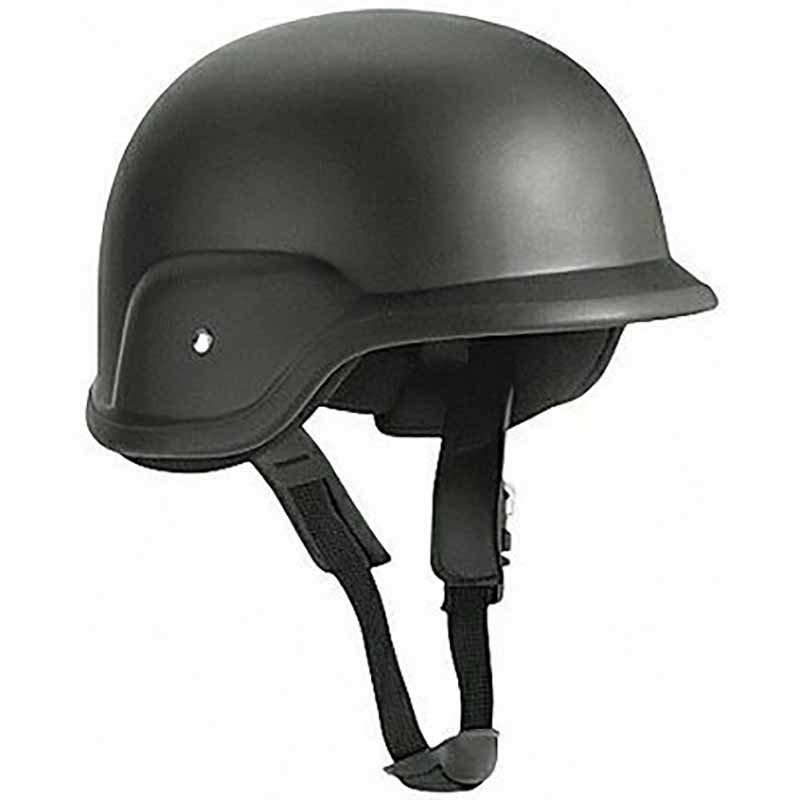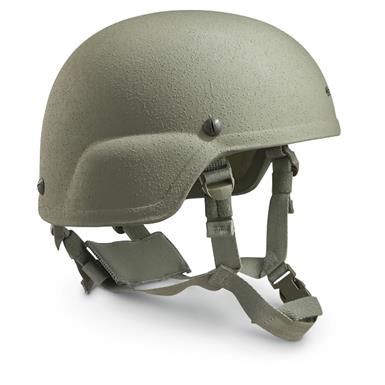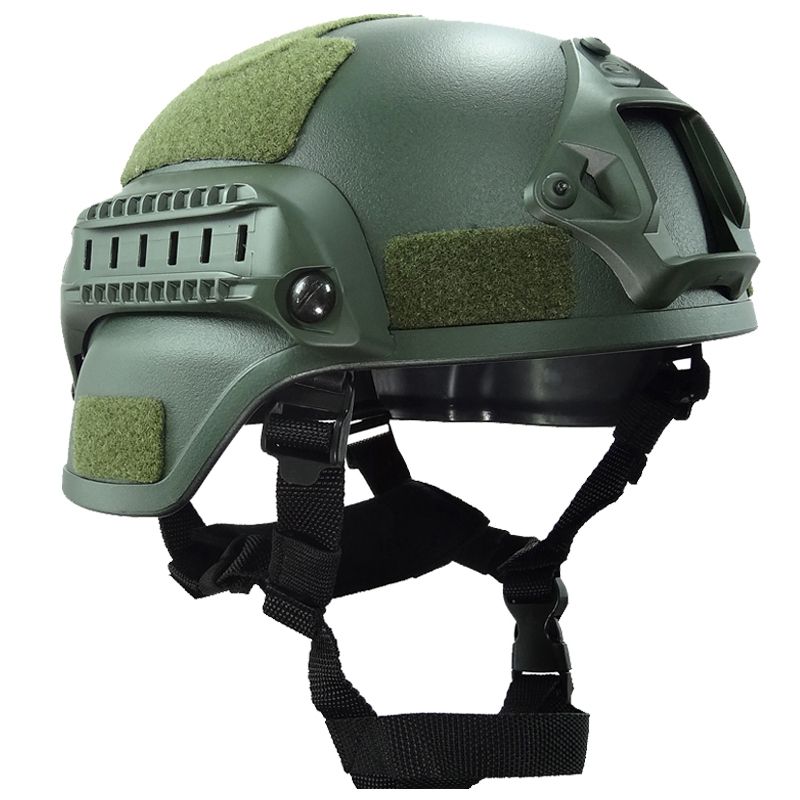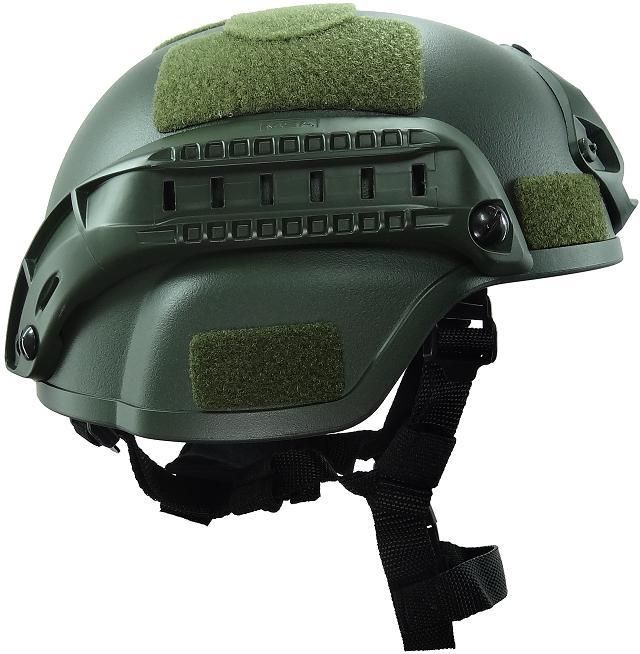A bulletproof helmet, or more accurately 'ballistic helmet', is a tactical helmet designed to protect the wearer's head from threats such as ballistic impact (bullets), blunt impact, and blast debris.
It is typically worn in conjunction with ballistic-resistant body armor to provide full coverage and protection.Traditionally, members of the military wear the ballistic helmet for combat, and it is also a common piece of gear for law enforcement in tactical situations, but even civilians just looking for extra ballistic protection when working with firearms can make good use of them.It has to be mentioned that no protective material currently on the market can technically be guaranteed "bulletproof." Readily available tactical equipment might be certified bullet resistant against a certain range of weapons, but that's more than adequate for most use cases.
Bear this in mind before you move on to purchase a new ballistic helmet. They won't stop every bullet coming at you, but that doesn't mean they won't still save your life.
.jpg)
.jpg)
Let's look at how bulletproof helmets have evolved over the years:
In the early days of warfare, soldiers protected their heads with cloth or leather to protect themselves.For most of the 20th century, combat helmets were essentially bowl-shaped steel shells that fit into a hard-hat type liner. The bulletproof helmet as we know it today first saw widespread adoption with World War I. Known as the M1917 helmet, the U.S. variation on the British Brodie helmet, did little more than keep soldiers' heads safe from explosion-propelled rocks in the trenches.U.S. Army infantryman wearing Brodie helmet, 1942 (just before it was replaced with the M1)
The U.S. government first utilized Kevlar in the manufacturing process for the M1 helmet liner making it one of the first Kevlar helmets. Used by the U.S. military from World War II to 1985, the M1 offered a moderate increase in protection from flying pieces of steel shrapnel, but it still wasn't bulletproof.They've come a long way since then.
FROM STEEL BOWLS TO SLEEK HEADGEAR RESISTANT TO MODERN WEAPONS OF WAR
In 1960, a new material called Aramid was developed courtesy of DuPont. Aramid is a durable fiber resistant to heat. This novel material was marketed as “Kevlar,” and -being a whopping five times stronger than steel - it revolutionized the design and production of ballistic body armor. In the 1970s, there came along another strong synthetic fiber of the Aramid family - Twaron. The fact is that both Kevlar and Twaron are five times stronger than steel and yet flexible, able to be incorporated into a variety of products that need strength and extreme durability, such as ballistic protective gear.
The main difference between the two materials lies in their manufacturers and their timeline of usage:Dupont gave us Kevlar, which came into commercial use in the 70s. Teijin gave us Twaron, which was first used commercially in 1986.These materials changed the game.
Clearly, ballistic helmets have been evolving to meet the needs of today's military and law enforcement officers. They've undergone major developments in terms of shape, weight, and materials, becoming stronger, lighter, and sleeker in cut to provide good visibility without sacrificing performance. The M1 helmet was eventually replaced by the Personnel Armor System for Ground Troops (PASGT).The PASGT was in turn replaced by the Modular Integrated Communications Helmet (MICH) designed and developed by the US Special Operations Command.
In 2002, the U.S. Army adopted MICH and renamed it to Advanced Combat Helmet (ACH).Compare all this to the future of military headgear, the Enhanced Combat Helmet, which can protect from up to NIJ level IV. You'll often see these acronyms used when referring to different kinds of helmets and how they're used. Today's ballistic helmets serve a dual purpose, not only protecting the head area from bullets, blunt impacts, and debris fragments, but also acting as mounts for extra gear.With advancements in combat technology, many modern helmets, especially those used by the military, must be able to support communications equipment and various gear and accessories such as an NVG shroud (night vision goggles).
.jpg)
.jpg)
TACTICAL HELMET TYPES
Today, there are three main types of helmets on the market: the Future Assault Shell Technology helmet (known as the FAST helmet), the Modular Integrated Communications (MICH) helmet, and the Personnel Armor System for Ground Troops (PASGT) helmet. Each helmet has a different history, design, and purpose.
PASGT ("K-POT," "KEVLAR HELMET")


The oldest and perhaps most influential design of the three ballistic helmets available for general purchase today, the PASGT (pronounced PAZ-get) was used by the U.S. military from 1983 to the mid 2000s as one component of a protective gear set that also included a ballistic vest. This ballistic helmet is a tried and true model and is still in use today by the U.S. Army Reserve and the U.S. Navy for sailors on warships. It's the original gold standard when it comes to ballistic protection.
Key features of this helmet include an outer shell usually of multi-layer Kevlar, a low cut over the ears, and a lip over the brow. It is available in a range of colors and patterns for use in different branches of the armed forces and weighs 3.1 lbs. to 4.2 lbs. (1420 g. to 1910 g.). With precise drilling into the Kevlar, the helmet can be outfitted with add-on accessories such as a mount assembly for night vision goggles and a riot control visor. Protection Group Denmark PASGT Level IIIA Ballistic Helmet
MICH ("ACH")


The MICH is the next generation of the PASGT.It was released in early 2001, after experiments aiming to design a ballistic helmet which was lighter and more comfortable yet still as protective as its predecessor. When the U.S. Army adopted the MICH in 2002, the helmet was renamed the Advanced Combat Helmet (ACH).The helmet weighs 3.0 lbs. to 3.6 lbs. (1360 g. to 1630 g.) and is made of an advanced Kevlar material. It comes in a range of camouflage patterns or solid black for use by SWAT teams.Two other main goals in the MICH's creation was that the helmet could easily be mounted with accessories and wouldn't shift forward over the eyes in certain positions when pushed by the high collar of the Interceptor (the vest component of the military body armor system).
To accomplish these aims, the brow was eliminated and the sides were raised, resulting in 8% less coverage but improved visibility, comfort, and situational awareness - a worthwhile trade-off. Rails were also added along the sides for mounting accessories without the need to drill into the Kevlar. The MICH is currently one of the helmets used by a number of armed forces, including the U.S. Marine Corps Forces Special Operations Command and the U.S. Air Force Security forces. Atomic Defense MICH 2000 IIIA Kevlar Ballistic Helmet
FAST ("HIGH CUT/" "ABOVE THE EAR/" "ATE"/ "MARITIME CUT"/"COMBAT HELMET")
.jpg)
.jpg)
The manufacturing company Ops-Core unveiled the FAST ballistic helmet at the 2009 SHOT Show, and it was soon issued to U.S. special operations forces in Afghanistan. Today, a number of special ops forces use different variants of the FAST. One immediately noticeable trait of the FAST setting it apart from any other ballistic helmet is that it features high cut sides, leaving the ears exposed. The helmet then curves back down to protect the occipital bone at the back of the head.
The original purpose of this high cut ear design was for use in maritime special operations. More traditional helmet models proved hazardous to wear at sea when travelling at high speeds because water could catch in the ear cups. The helmet's high cut and the side rail system allow for the mounting of additional combat accessories including earphones, electronic ear muffs, and a night vision goggle shroud.
Obviously, a MICH helmet supports these accessories, too, but another distinguishing feature of the FAST is its weight.It is significantly lighter than the MICH at only 2.2 lbs. to 3.0 lbs. (1143 g. to 1354 g.) as it's made of a composite of Carbon, Uni-directional Polyethylene, and Woven Aramid.